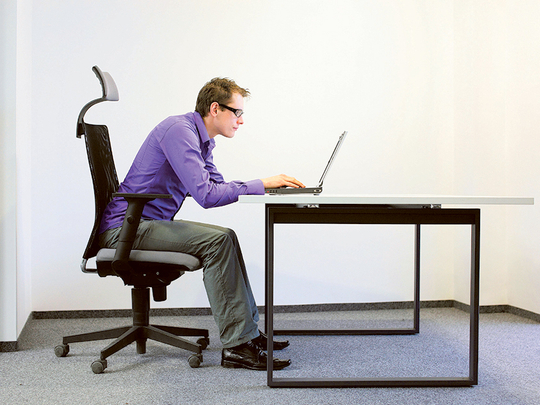
Dubai: The more office employees engage with new technologies, the more postures they will adopt over time which might not be supported by traditional office chairs, a global study has found.
Working with laptops and other mobile devices in the office for more than six hours a day has changed the way employees move and change positions on the chair throughout the day, a research conducted by Steelcase, a global furniture company revealed.
And the more office employees continue to ignore the way technology impacts their bodies as they work, the more prone they are to long-term injuries, neck and back pain and to experience a reduction in concentration and creativity.
After an analysis of 10,739 employees across six continents, the Global Posture Study showed that men and women have already adopted nine different new postures such as The Strunch (stretched out over the desk and resting weight on desk), The Cocoon (reclining and resting device on thighs), The Draw (pulling back from desk when working with tablets), The Trance (concentrated reading on screen), and five others.
“The evidence from the study clearly showed the multiplicity of postures adopted by workers and how comfortable they are in using a widening array of technology, said James Ludwig , Vice-President of Global Design and Product Engineering at Steelcase.
“Many people are using chairs that were designed well before these new devices became common tools at work. Back then chairs were created to help people hold one pose in front of a computer all day.”
According to Kusum Jham, a physiotherapist at Medcare Hospital, approximately 50 per cent of patients coming to them with neck pain or back pain and poor ergonomics and sedentary lifestyles are to blame in most cases.
“Commonly, patients experience neck pain accompanied with headache and dizziness and back pain, which radiates to lower limbs. At times it is also accompanied by motor weakness in extremities and/or tingling and numbness in limbs,” Jham said.
Dr Nikola Vagic, Specialist Orthopaedic Spine Surgeon and Traumatologist at Medcare Hospital, said the consequence of improper posture and lack of exercise is found to be the cause of chronic back and neck pain in 85 per cent of cases due to activation of muscles triggering points, which is very difficult to treat since muscles which are off balance need long-term treatment and significant effort to be returned to a pain-free condition.
“Proper posture is important to maintain the well-being of the spine and muscle balance. Desktop computers were much more suitable for adjustment of posture,” he said. But even when using laptops, people can work by adopting a posture wherein their ears are parallel to the level of their shoulders and their trunk is supported with a chair of a proper size and angled 30 degrees backwards.”
Vagic recommends that office employees speak to their employers about getting appropriate chairs and desktops that can be adjusted and that they stand up frequently at least every hour, and do a few minutes of basic stretching.
Gulf News spoke to a number of office employees who spend more than nine hours a day sitting in a chair, and most of them said that the postures they have adopted while using laptops or other mobile devices at work has caused pain in their neck and back.
Ali Saeed, a Jordanian assistant accountant, said that he gets upper back pain and stiffness in his legs when sitting for many hours at work and he tries to do some stretching at his chair when he gets fatigued.
“I work for many hours with my arms stretched forward over the table when using my laptop, and when I get tired, I crack my back and fingers to feel better,” said Saeed. “I also tend to sit tucking one leg under me, with the other leg down or recline with my legs stretched to the front when using the laptop.”
Bhakti More said she had worked as an office employee in a design firm previously for seven years and began experiencing a lot of pain in her lower back because she sat on the chair for eight to 10 hours a day.
“I didn’t move all day at times, especially when I was under pressure. When things started getting worse with my back, I began doing chair yoga and got some tips on how to stretch my body regularly when sitting for so long,” More said.
Sharing his experience of working long hours in the office, Shabeeb Abdul Kader, an Indian Project Director at Paramount Middle East, said he prefers to find a comfortable position, rather than using any bulky ergonomic accessories for laptops.
While sitting at office, I try to keep the best no-pain laptop position. I always try to keep optimal postures while sitting at office in order to reduce stress on the body. It’s all about keeping the computer screen at the optimal height and viewing distance that will help reduce muscle tension in the neck and shoulders, as well as preventing strain to eyes,” he said.
Dr Vishwas Chhabra, a life consultant, said ergonomically designed chairs allow the user to sit in a balanced position but it may not bring the expected benefits.
“The chair is only one of many components to be considered in workplace design,” he said. “The sitting position depends on an individual’s personal habits. One has to learn and practice proper and healthy postures of sitting.”
Speaking about Chair Yoga, Chhabra said that it is an easy form of yoga for those who are unable to do traditional yoga due to lack of time, age or any kind of disability. It comprises of 86 postures that can be effortlessly practiced sitting on a chair or standing with the support of it.
“Chair yoga can be done anywhere with limited mobility and energy, say in an office, in an airplane, at home,” he said.
He offers a few tips to do such exercises: “Look at the roof at least 3-4 times a day [stretches the neck muscles and relaxes them]; watch your feet and do a complete forward bend [stretches the back and spine]; sit comfortably and blink 10-20 times quickly and then close eyes for 10 seconds; and stretch your arms up [as though reaching out to the ceiling].”







